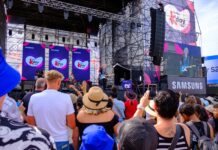A new interactive installation designed by award-winning designer Es Devlin, and commissioned by Mercedes-Benz South Africa, is now open to the public. Devlin is known for her large-scale sculptural works that fuse technology and poetry, including the fluorescent Fifth Lion which landed in London’s Trafalgar Square last month roaring collective poetry generated by artificial intelligence, as well as the London Olympic Closing Ceremony and touring stage sculptures for Beyoncé and U2.
Launched on 1 November 2018 and situated on Silo Square at Cape Town’s V&A Waterfront, Devlin’s new sculptural work ZOETROPE will remain open for a full year, with visitors welcome free of charge. Using solar power and responding to the pioneering Electrical Intelligence (EQ) technology developed by Mercedes-Benz, the ZOETROPE imagines the potential for a future global network of solar-powered pavilions specific to their locations, each one acting as a unique charging station for the mind of the driver.
In conceptualising the ZOETROPE pavilion, Devlin took a map of Cape Town and chose 12 points that express the geographic and demographic range of life within a 100km radius of the site – from an underwater kelp forest and rooftop football match, to choral groups and solar power installers. Working closely with South African filmmakers, Devlin gathered footage from these locations that was then edited into 12 one-minute films that form the narrative inside the ZOETROPE.
Mirroring a journey through the built environment of the city of Cape Town in both physical and cultural terms, ZOETROPE is constructed using only local materials and talent. It comprises a steel frame structure clad in 72 concrete panels which were made using sand sourced from the 12 filming locations and the same cement used to construct the original Silo building (which lies adjacent the pavilion). The structure merges with its historic surroundings through its very DNA, as well as the geographic imagery experienced once you enter the installation. Roofed with modern solar power technology, the sculpture is completely off the grid, producing 11.4 kW of energy, which powers the audiovisual equipment used inside.
Upon entering, visitors will walk through a labyrinthine route that spans the length of the 12 one-minute films. Through its use of light, colour and sound, the sculpture creates an immersive journey that leaves the visitor with a greater understanding of place, as well as the relational symbiosis between solar energy, location and electric mobility. This journey aims to foster an appreciation of the spatial experience that technology such as Mercedes-Benz EQ offers.
The Zoetrope piece by Es Devlin imagines a future in which both the electric vehicle and its driver are recharged by solar power. #SwitchtoEQ #EQA #MercedesBenz @MercedesBenz_SA pic.twitter.com/6OdJsquiZu
— Cape Town Guy (@TheCapeTownGuy) November 1, 2018
“Our landscapes bear the traces of every successive historic transport system overlaid: each new mode of human connection imprints its geometry onto our planet’s geography. First it was paths traced by human feet, the location of resting places determined by levels of human endurance; then tracks from cart wheels and a network of coaching inns with stables, their frequency determined by the metabolism of a horse. Next the size of gas tanks in fossil-fuel driven cars determined the geometry of the global highway petrol station network,” explains Devlin of the concept.
The pavilion explores how the electric period in transport history will leave its mark. “Rapid advances in lithium battery technology are extending the periods of travel and diminishing the durations of charging stops at an exponential rate. How should we approach the network of electric vehicle charging stations that is set to emerge all over the globe? How should we spend our time while we wait for our electric vehicles to recharge mid journey?” asks Devlin.
The ZOETROPE project began in March 2018 after the annual Design Indaba conference, when Mercedes-Benz South Africa approached Design Indaba founder Ravi Naidoo to find a way to interpret electric mobility. Naidoo proposed that Devlin create a thought-provoking public piece – a first for South Africa and the first of its kind in the world. The ZOETROPE is proudly project managed by Design Indaba, global leaders in innovative creativity.
Mercedes-Benz commissioned Devlin to create this unique work to ignite the public imagination around the exciting future offered by electric mobility. “The automotive industry is currently undergoing a transformation that offers great opportunities to shape the future in lasting ways through innovation, inspiration and fascination. Mercedes-Benz is proud to have commissioned an artwork that embodies emotion and intelligence while considering the future of mobility and introducing South Africa to our EQ (Electric Intelligence) technologies,” says Johannes Fritz, Co-CEO of Mercedes-Benz South African and Executive Director of Mercedes-Benz Cars.
Devlin’s sculptures have been seen on a vast range of global stages from the Royal Opera House and Royal Ballet to the Olympic stadium in Rio. The Singing Tree, her choral collective carol installation at the London V&A Museum, fused machine-learning technology with sound and light and was viewed by over 10 million visitors during the Christmas period of 2017. Mirrormaze, 2016’s interactive installation, generated queues around the block in South East London.
Devlin’s practice was the subject of a major 2017 Netflix documentary Abstract: The Art of Design. She is the winner of numerous awards including three Olivier Awards, the 2017 London Design Medal, a UAL fellowship and an OBE. She has just been named as the winner of the much-coveted architectural commission to design the UK Pavilion at EXPO 2020 Dubai.
Provided by Mercedes-Benz South Africa




























